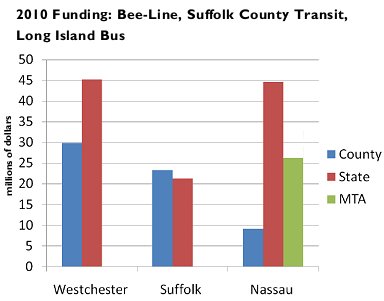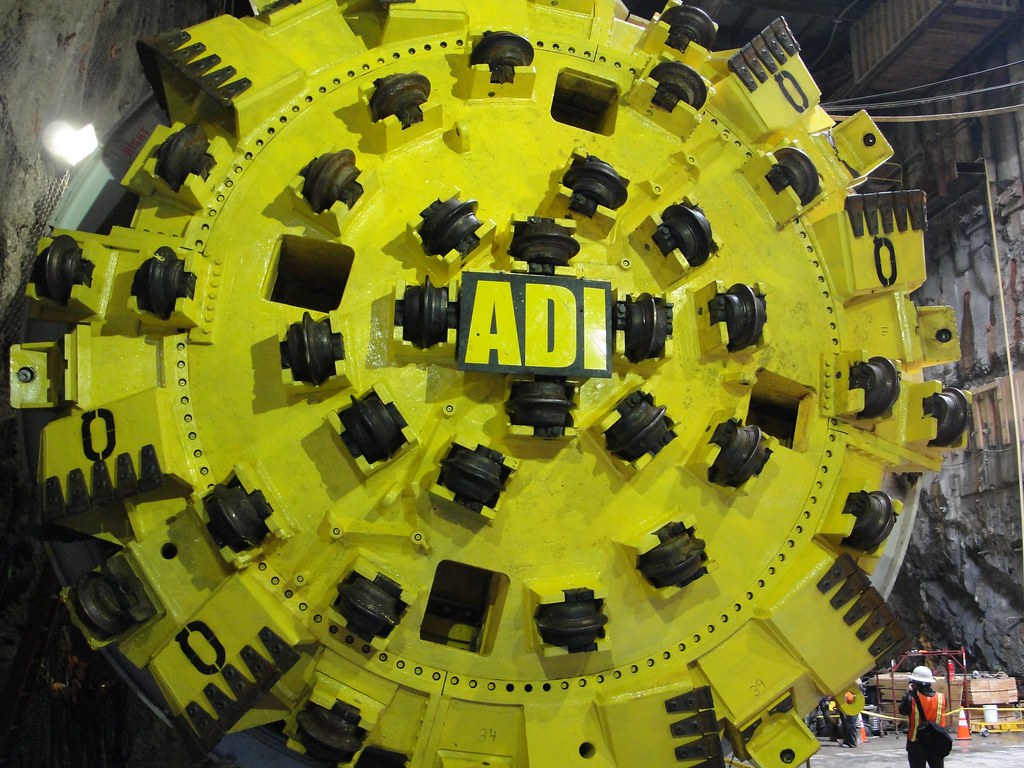
Nassau County has not invested in its own bus system. (Graph via TSTC)
Thanks to last-minute action by the New York State Senate, Nassau County bus riders will be spared a slate of cuts that would have decimated Long Island Bus service. On Friday, the MTA, Nassau County and Senator Republicans led by Charles Fuschillo (R, Merrick) and Jack Martins (R-C-I, Mineola) announced an $8.6 million compromise that will see the MTA receive half of the money it wanted in exchange for a commitment to keep service alive through December 31. It’s a start but only that.
“We have heard from many of our constituents that depend on Long Island Bus services to get to work, school or go shopping,” Senate Majority Leader Dean G. Skelos said in a statement. “They are very concerned that if these cuts go through, they will have no other way to get around. Fortunately, we were able to reach an agreement to avert the cuts and prevent any disruption in service. I want to thank Senator Fuschillo and Senator Martins for their leadership in responding to this issue.”
Essentially, the Senate has made $8.6 million in capital money available to the MTA for LI Bus operations. This will be added to the $52.4 million appropriate by the 2011-2012 budget for the service, and the 27 route cuts will be off the table. Nassau County though says it will still seek to remove the MTA as the service’s operator by the end of the year.
“I applaud the efforts of our Nassau County State Senators for working with me to come together in support of our residents that rely on Long Island Bus for their transportation needs,” Nassau County Executive Edward Mangano, who has called for MTA CEO and Chairman Jay Walder’s resignation over the conflict, said. “Their assistance ensures that all current bus routes will remain intact. I remain committed to fostering communication and working with the MTA to ensure a smooth transition as we enter a public-private partnership starting January 2012. This public-private partnership will enable us to provide comparable bus routes at a much more affordable rate to Nassau County taxpayers.”
Transit advocates though were less than thrilled with the news simply because Mangano’s insistence on attempting to privatize the service seems to be utterly failing. “Over the coming months, Nassau County will have to show the same type of leadership,” the Tri-State Transportation Campaign said in a statement. “The deal gives Nassau County Executive Mangano more time to come up with a workable proposal for a local transit system. None of the privatization schemes released by the county so far appear to qualify. Affordable transit that maintains access to jobs, education, and social services is critical to the county’s economy and quality of life.”
It’s tough to see where this debacle goes from here. As Jim O’Grady at Transportation Nation noted this weekend, “Nassau County is one of the richest counties in the nation, but has, over the years, run its finances into the ground.”
The county is going to have to figure out a way to either work with the MTA or find a better solution. Privatization, in the model Mangano envisions, isn’t feasible. The County will likely have to pay more for transit under a privatized solution, and it can’t continue to expect the state to bail it out when its executive starts behaving like a spoiled child who doesn’t understand his constituents’ needs or demands. For now, the bus service has been saved, and while politicians are slapping themselves on the back, this is hardly a great cause for celebration.














 My morning commute from Brooklyn to law school always involves the B train, and it more often than not involves some combination of an inaudible public address system and deafening feedback at some too-early hour of the morning. Of course, those problems aren’t solely unique to the B train. In fact, in-car PA systems throughout the subway range from too loud to inaudible, and even the new pre-recorded announcements seem to have volume control issues. But the Straphangers have anointed a champion in the Bad PA System category, and my B train has won.
My morning commute from Brooklyn to law school always involves the B train, and it more often than not involves some combination of an inaudible public address system and deafening feedback at some too-early hour of the morning. Of course, those problems aren’t solely unique to the B train. In fact, in-car PA systems throughout the subway range from too loud to inaudible, and even the new pre-recorded announcements seem to have volume control issues. But the Straphangers have anointed a champion in the Bad PA System category, and my B train has won.
